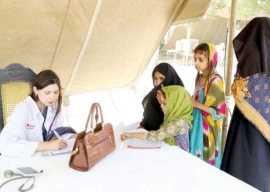
Pakistan, the fifth most populous country in the world, is on track to become the third most populous nation by 2053, surpassing the United States of America.
The exponential population growth in Pakistan raises significant concerns about the implications on human and economic development, climate change, water scarcity, poverty, security, and stability.
These views were expressed by Dr Sara Shahzad, a health advisor working on, health systems, and demography in an international public sector organisation based in Pakistan during an interview with The Express Tribune.
“High population growth remains a leading factor behind poor health and education outcomes, soaring unemployment rates, inequality, and the country's overall economic situation.”
She highlighted that according to the United Nations' medium projection, Pakistan's working-age population (15-64) as a proportion of the total population will reach its peak around 2050. This demographic shift presents a time-limited window of opportunity to harness the benefits of a demographic dividend- a multiyear economic growth, she noted.
“Many countries, particularly in Asia, have experienced significant and sustained economic growth by capitalising on this. However, realising this potential requires implementing appropriate social and economic policies and programmes, specifically in the areas of family planning, girls' education, and youth’s economic empowerment.”
Dr Sara lamented that due to a lack of foresight and political will, Pakistan has wasted nearly three decades of the demographic transition opportunity. If the country continues on its current trajectory of business-as-usual, it is poised to face a demographic disaster, she underscored.
A modelling study by the United Nations Population Fund (UNFPA) projects dire consequences if no corrective measures are taken. By 2030, approximately 89.9 million people, or 34.4% of the population, could fall below the poverty line, she said.
Furthermore, 97.7 million individuals, or 37.4% of the population, may experience food insecurity. Alarming statistics also indicate that 11.1 million children, nearly 35.9% will face stunting, while a staggering 58% of children are expected to achieve only minimal proficiency in reading.
Dr Sara said access to safe drinking water is estimated to be out of reach for 57% of the population, and 43% of urban dwellers may find themselves living in slums. “The high population growth rate will undoubtedly exacerbate climate change adaptation and resilience issues, strain water resources, and potentially contribute to political instability and conflict.”
In light of these challenges, key stakeholders, including the government, development partners, and relevant authorities, are urged to take immediate action, she said and highlighted five critical demands that should be addressed. She said it is crucial to elevate population policy as a national priority and integrate it into all development initiatives.
“Regular performance evaluations at the highest levels, such as the prime minister and chief minister, are necessary to monitor commitments regarding population dynamics.”
The expert suggested increasing public financing and improving expenditure efficiency for family planning nationwide.
Published in The Express Tribune, July 12th, 2023.








1726722687-0/Express-Tribune-Web-(9)1726722687-0-270x192.webp)













COMMENTS
Comments are moderated and generally will be posted if they are on-topic and not abusive.
For more information, please see our Comments FAQ